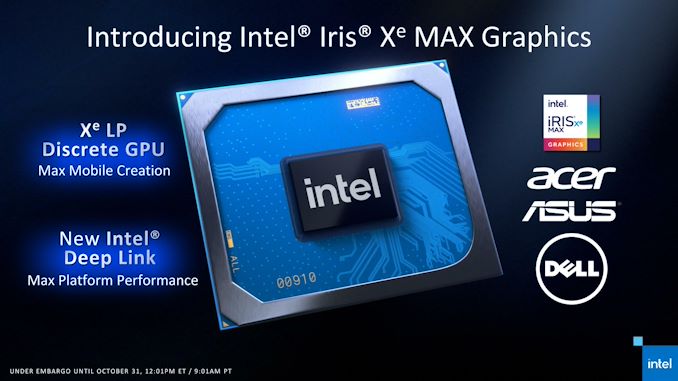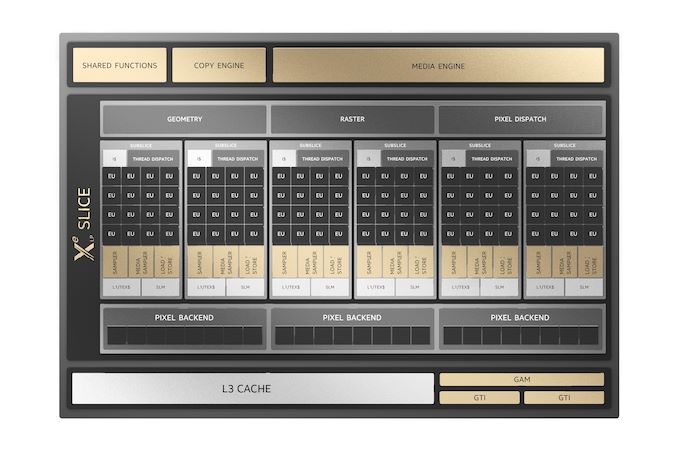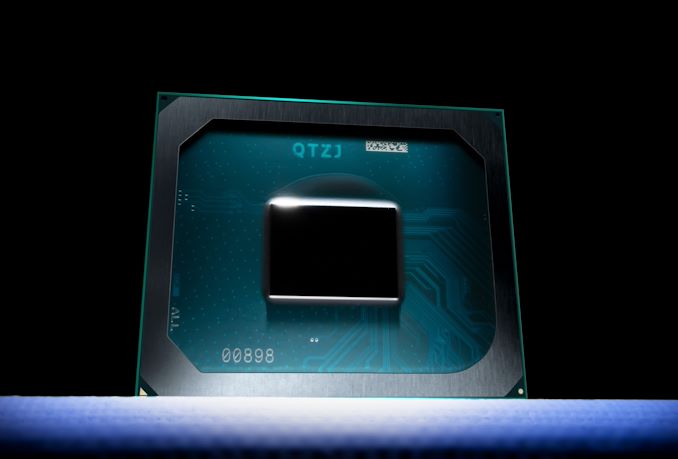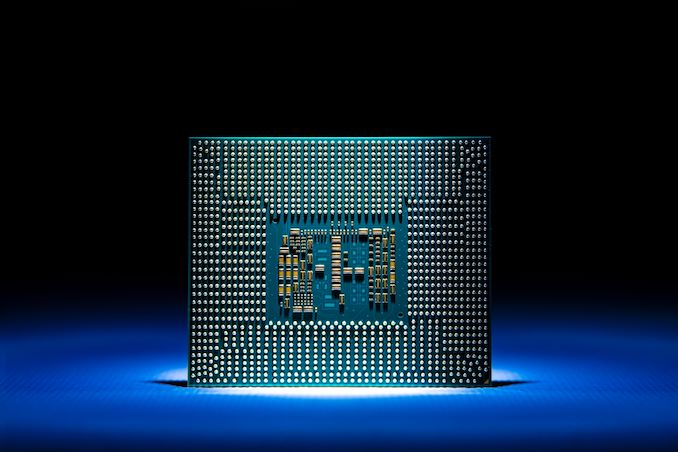Intel’s Discrete GPU Era Begins: Intel Launches Iris Xe MAX For Entry-Level Laptops
by Ryan Smith on October 31, 2020 12:01 PM EST
Today may be Halloween, but what Intel is up to is no trick. Almost a year after showing off their alpha silicon, Intel’s first discrete GPU in over two decades has been released and is now shipping in OEM laptops. The first of several planned products using the DG1 GPU, Intel’s initial outing in their new era of discrete graphics is in the laptop space, where today they are launching their Iris Xe MAX graphics solution. Designed to complement Intel’s Xe-LP integrated graphics in their new Tiger Lake CPUs, Xe MAX will be showing up in thin-and-light laptops as an upgraded graphics option, and with a focus on mobile creation.
We’ve been talking about DG1 off and on since CES 2020, where Intel first showed off the chip in laptops and in a stand-alone development card. The company has continuously been coy about the product, but at a high level it’s been clear for some time that this was going to be an entry-level graphics solution suitable for use in smaller laptops. Based heavily on the integrated graphics in Intel’s Tiger Lake-U CPU, the Xe-LP architecture GPU is a decidedly entry-level affair. None the less, it’s an important milestone for Intel: by launching their first DG1-based product, Intel has completed first step in their plans to establish themselves as a major competitor in the discrete GPU space.
Sizing up Intel’s first dGPU in a generation, Intel has certainly made some interesting choices with the chip and what markets to pursue. As previously mentioned, the chip is based heavily on Tiger Lake-U’s iGPU – so much so that it has virtually the same hardware, from EUs to media encoder blocks. As a result, Xe MAX isn’t as much a bigger Xe-LP graphics solution so much as it is an additional discrete version of the Tiger Lake iGPU. Which in turn has significant ramifications in the performance expectations for the chip, and how Intel is going about positioning it.
To cut right to the chase on an important question for our more technical readers, Intel has not developed any kind of multi-GPU rendering technology that allows for multiple GPUs to be used together for a single graphics task (ala NVIDIA’s SLI or AMD’s CrossFire). So there is no way to combine a Tiger Lake-U iGPU with Xe MAX and double your DOTA framerate, for example. Functionally, Xe MAX is closer to a graphics co-processor – literally a second GPU in the system.
As a result, Intel isn’t seriously positioning Xe MAX as a gaming solution – in fact I’m a little hesitant to even attach the word “graphics” to Xe MAX, since Intel’s ideal use cases don’t involve traditional rendering tasks. Instead, intel is primarily pitching Xe MAX as an upgrade option for mobile content creation; an additional processor to help with video encoding and other tasks that leverage GPU-accelerated computing. This would be things like Handbrake, Topaz’s Gigapixel AI image upsampling software, and other such productivity/creation tasks. This is a very different tack than I suspect a lot of people were envisioning, but as we’ll see, it’s the route that makes the most sense for Intel given what Xe MAX can (and can’t) do.
At any rate, as an entry-level solution Xe MAX is being setup to compete with NVIDIA’s last-generation entry-level solution, the MX350. Competing with the MX350 is a decidedly unglamorous task for Intel’s first discrete graphics accelerator, but it’s an accurate reflection of Xe MAX’s performance capabilities as an entry-level part, as well as a ripe target since MX350 is based on last-generation NVIDIA technology. NVIDIA shouldn’t feel too threatened since they also have the more powerful MX450, but Xe MAX has a chance to at least dent NVIDIA’s near-absolute mobile marketshare by going after the very bottom of it. And, looking at the bigger picture here for Intel’s dGPU efforts, Intel needs to walk before they can run.
Finally, as mentioned previously, today is Xe MAX’s official launch. Intel has partnered with Acer, ASUS, and Dell for the first three laptops, most of which were revealed early by their respective manufacturers. These laptops will go on sale this month, and the fact that today’s launch was timed to align with midnight on November 1st in China offers a big hint of what to expect. Intel’s partners will be offering Xe MAX laptops in China and North America, but given China’s traditional status as the larger, more important market for entry-level hardware, don’t be too surprised if that’s where most Xe MAX laptops end up selling, and where Intel puts its significant marketing muscle.
| Intel GPU Specification Comparison | ||||||
| Iris Xe MAX dGPU |
Tiger Lake iGPU |
Ice Lake iGPU |
Kaby Lake iGPU |
|||
| ALUs | 768 (96 EUs) |
768 (96 EUs) |
512 (64 EUs) |
192 (24 EUs) |
||
| Texture Units | 48 | 48 | 32 | 12 | ||
| ROPs | 24 | 24 | 16 | 8 | ||
| Peak Clock | 1650MHz | 1350MHz | 1100MHz | 1150MHz | ||
| Throughput (FP32) | 2.46 TFLOPs | 2.1 TFLOPs | 1.13 TFLOPs | 0.44 TFLOPs | ||
| Geometry Rate (Prim/Clock) |
2 | 2 | 1 | 1 | ||
| Memory Clock | LPDDR4X-4266 | LPDDR4X-4266 | LPDDR4X-3733 | DDR4-2133 | ||
| Memory Bus Width | 128-bit | 128-bit (IMC) |
128-bit (IMC) |
128-bit (IMC) |
||
| VRAM | 4GB | Shared | Shared | Shared | ||
| TDP | ~25W | Shared | Shared | Shared | ||
| Manufacturing Process | Intel 10nm SuperFin | Intel 10nm SuperFin | Intel 10nm | Intel 14nm+ | ||
| Architecture | Xe-LP | Xe-LP | Gen11 | Gen9.5 | ||
| GPU | DG1 | Tiger Lake Integrated |
Ice Lake Integrated | Kaby Lake Integrated | ||
| Launch Date | 11/2020 | 09/2020 | 09/2019 | 01//2017 | ||
Kicking off the deep dive portion of today’s launch, let’s take a look at the specs for the Xe MAX. As previously mentioned, Xe MAX is derived from Tiger Lake’s iGPU, and this is especially obvious when looking at the GPUs side-by-side. Xe-LP as an architecture was designed to scale up to 96 EUs; Intel put 96 EUs in Tiger Lake, and so a full DG1 GPU (and thus Xe MAX) gets 96 EUs as well.
In fact Xe MAX is pretty much Tiger Lake’s iGPU in almost every way. On top of the identical graphics/compute hardware, the underlying DG1 GPU contains the same two Xe-LP media encode blocks, the same 128-bit memory controller, and the same display controller. Intel didn’t even bother to take out the video decode blocks, so DG1/Xe MAX can do H.264/H.265/AV1 decoding, which admittedly is handy for doing on-chip video transcoding.
And, to be sure, Intel has confirmed that DG1 is a real, purpose-built discrete GPU. So Xe MAX is not based on salvaged Tiger Lake CPUs or the like; Intel is minting discrete GPUs just for the task. As is usually the case, Intel is not disclosing die sizes or transistor counts for DG1. Our own best guess for the die size is an incredibly rough 72mm2, and this is based on looking at how much of Tiger Lake-U’s 144mm2 die is estimated to occupied by GPU blocks. In reality, this is probably an underestimate, but even so, it’s clear that DG1 is a rather petite GPU, thanks in part to the fact that it’s made on Intel’s 10nm SuperFin process.
Overall, given the hardware similarities, the performance advantage that Xe MAX has over Tiger Lake’s iGPU is that the discrete adapter gets a higher clockspeed. Xe MAX can boost to 1.65GHz, whereas the fastest Tiger Lake-U SKUs can only turbo to 1.35GHz. That means all things held equal, the discrete adapter has a 22% compute and rasterization throughput advantage on paper. But since we’re talking about laptops, TDPs and heat management are going to play a huge role in how things actually work.
Meanwhile the fact that Xe MAX gets Tiger Lake’s memory controller makes for an interesting first for a discrete GPU: this is the first stand-alone GPU with LPDDR4X support. Intel’s partners will be hooking up 4GB of LPDDR4X-4266 to the GPU, which with its 128-bit memory bus will give it a total memory bandwidth of 68GB/sec. Traditionally, entry-level mobile dGPUs use regular DDR or GDDR memory, with the latter offering a lot of bandwidth even on narrow memory buses, but neither being very energy efficient. So it will be interesting to see how Xe MAX’s total memory power consumption compares to the likes of the GDDR5/64-bit MX350.
As an added bonus on the memory front, because this is a discrete GPU, Xe MAX doesn’t have to share its memory bandwidth with other devices. The GPU gets all 68GB/sec to itself, which should improve real-world performance.
And since Xe MAX is a discrete adapter, it also gets its own power budget. The part is nominally 25W, but like TDPs for Intel’s Tiger Lake CPUs, it’s something of an arbitrary value; in reality the chip has as much power and thermal headroom to play with as the OEMs grant it. So an especially thin-and-light device may not have the cooling capacity to support a sustained 25W, and other devices may exceed that during turbo time. Overall we’re not expecting any more clarity here than Intel and its OEMs have offered with Tiger Lake TDPs.
Last but not least, let’s talk about I/O. As an entry-level discrete GPU, Xe MAX connects to its host processor over the PCIe bus; Intel isn’t using any kind of proprietary solution here. The GPU’s PCIe controller is fairly narrow with just a x4 connection, but it supports PCIe 4.0, so on the whole it should have more than enough PCIe bandwidth for its performance level.
Meanwhile the part offers a full display controller block as well, meaning it can drive 4 displays over HDMI 2.0b and DisplayPort 1.4a at up to 8K resolutions. That said, based on Intel’s descriptions it sounds like most (if not all) laptops are going to be taking an Optimus route, and using Tiger Lake’s iGPU to handle driving any displays. So I’m not expecting to see any laptops where Xe MAX’s display outputs are directly wired up.














118 Comments
View All Comments
WaltC - Saturday, October 31, 2020 - link
What I enjoyed is that we were spared Act 2 of the 'Larrabee' hype train! This isn't going to offer AMD or nVidia any competition in the discrete GPU space, and it's always better to have low expectations that are justified than to see tons of crazy hype that isn't, imo.Azethoth - Saturday, October 31, 2020 - link
This sure feels like Larrabee all over again. A piece of garbage that does not compete except if you squint just right on a monday with a hangover.The real question is how soon do they kill it off. Or will Intel suddenly grow the ovaries needed to birth a proper GPU. You know, like what they said they were working on. We all remember that right? nVidia is making the monie$ at GPU, and so will we!
lmcd - Saturday, October 31, 2020 - link
Intel hasn't made a discrete graphics card before. This is a low-risk design (even the same memory controller) and imo is basically practice + a workaround for Tiger Lake 28W max TDP and memory bandwidth. AMD's first Ryzen APU had less marketplace value than this but look where they are now!velanapontinha - Saturday, October 31, 2020 - link
Yes, they have built a dGPU before, and it was rather nice, although a bit late to the game and short lived. It was called intel 740, I had one over 20 years ago.lmcd - Saturday, October 31, 2020 - link
How many people who worked on that project do you think still work in Intel's GPU division?Buck Turgidson - Saturday, October 31, 2020 - link
Yeah, the i740 was actually solidly competitive with the RivaTNT and other such cards (which oddly, because of the Voodoo 1&2, considered unified solutions, as they contained 2D display hardware).I think Intel has struggled in GPU because they suffer from “not-invented-here” syndrome and buying their own BS. I don’t think they lack the know-how, but they lack the commitment to GPU design principles. They kept trying to repurpose elements of general purpose ISA’s and uarch’s, rather than simply applying themselves to the task of a purpose built high-performance GPU architecture. Meanwhile the iGPU stuff is so constrained by transistor or TDP budgets, those teams can’t stretch their legs (but I bet, if given a green light, the could produce something very impressive).
Intel is a weird company; I worked for many years at Microsoft, and I remember getting into arguments with visiting Intel engineers (specifically around the very real efficiency issues with Netburst). I’d come from the semiconductor business, and I felt that Intel had simply made very poor decisions with Netburst (overly deep pipelining that was prone to bubbles and stalls, questionable branch prediction logic, heavy reliance on compiler optimizations/hints, too many transistors dedicated to depth of pipelines, not enough to number of pipelines, counterproductive obsession with clockspeed). Everyone I spoke to at Intel seemed to buy their own BS. Don’t even get me started on the IA64 folks; hell, I wanted to like Itanium, I wrote a whole compsci research paper on VLIW back in the early 90’s, but man those first sets of test machines we got were really disappointing. I know a couple of the guys who worked on MSVC for IA64, they sure weren’t having a good go of it back then.
Not to bag on Intel, they’ve been home to some of the finest engineers in the industry for longer than I’ve been alive. When they deliver, they deliver big, and from Conroe up to when AMD dropped Zen, they pretty much ruled the roost. Frankly, when Intel does finally stop messing around with bad ideas, and commits their extensive knowhow to building a proper scalable (to the high-end) GPU architecture, I’m willing to bet it’ll be a monster.
If there’s one thing I’ve learned, watching ISA’s come and go, while Intel and the x86 chug along, never underestimate them.
Sivar - Sunday, November 1, 2020 - link
Wisely spoken.Zingam - Monday, November 2, 2020 - link
I guess Intel is no longer the engineering company it used to be. It is the for-profit cash cow and it needs to make money now and it just happens to produce silicon along the way. And I guess it is a PC place with plenty of PC external contractors.Smell This - Monday, November 2, 2020 - link
The i740 sucked. The only good thing about it, the discreet evolved into the i810e GMA IGP chipset (I think I got that right).
Spunjji - Sunday, November 1, 2020 - link
I'd ask how you figured that AMD's first Ryzen APU had less marketplace value than this, but it's such a prima-facie absurd statement that I genuinely have very little interest in whatever pretzel logic is behind it. Here's your comment, expanded to a full argument:"The first x86 mobile CPU with powerful graphics to seriously compete against an Intel CPU for nearly ten years had less value in the marketplace than a dGPU with terrible gaming drivers that barely competes with two-generation-old technology and has no killer apps outside of gaming to properly justify it".
The mind boggles.